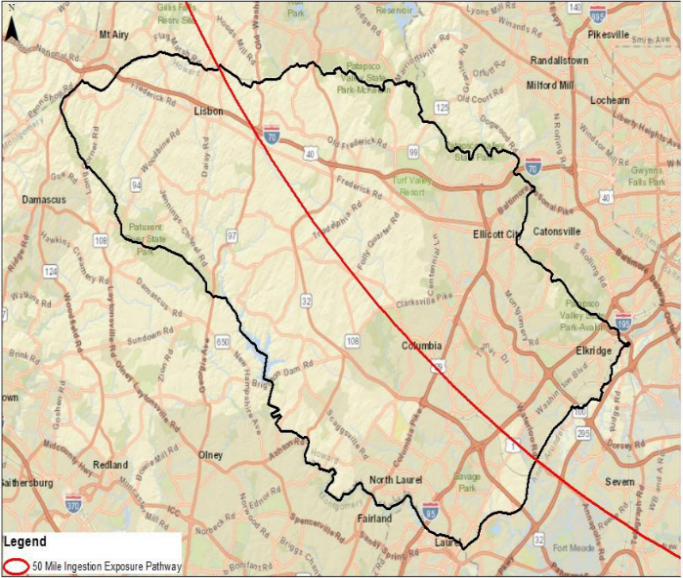Public Health Preparedness
The Howard County Health Department works with County, State and Federal partners to provide resources to residents on a possible response to a nuclear/radiological or biological/chemical hazard in the community. In preparation for a potential emergency, the information below can provide guidance on what the community can expect from a public health emergency response.
Howard County Office of Emergency Management Hazard Information
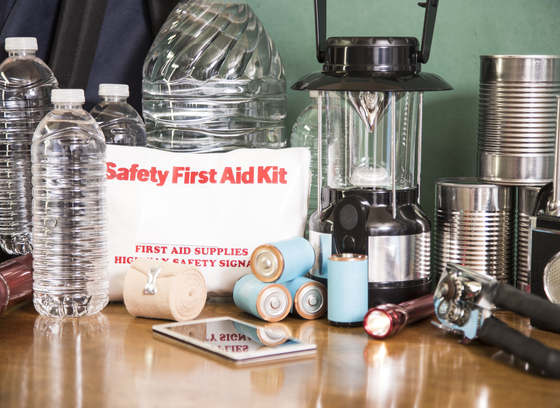
Nuclear/Radiological Hazard Preparedness
Howard County Information
A radiological attack may occur anywhere in Howard County. Likely targets for radiological attacks in Howard County include densely populated public areas such as schools, commercial facilities, event venues, and office buildings.
The location of Howard County may increase local vulnerability to radiological attacks and other terrorism-related attacks. Howard County is in close proximity to valuable terrorist targets including Washington, D.C., the City of Baltimore, the Port of Baltimore, and BWI Airport. Due to its proximity to the NCR, many Federal agencies, defense contractors, and high-profile targets maintain facilities within Howard County.
Unintentional radiological substance releases are most likely to occur in areas where radiological substances are frequently kept or transported. Radiological substances may be present in many of the medical centers and research facilities in and around Howard County. Radiological substances are transported through Howard County, making areas near railways and major roadways particularly vulnerable to unintentional radiological substance releases. There are no nuclear power plants in Howard County. Due to the distance of Howard County from Peach Bottom Atomic Power Station (PBAPS) (i.e., within 50-miles), it is likely that the County and residents may be impacted should there be a radiological emergency at PBAPS. Protective actions that may be implemented following an emergency at PBAPS are:
- Evacuating an area
- Sheltering-in-place within a building or protective structure
- Administering Potassium Iodide (KI) as a supplemental action
- Relocation
- Acquiring an alternate source of drinking water, and
- Interdiction of food/milk.
Howard County Office of Emergency Management Radiological Hazard Information
Howard County Office of Emergency Management Nuclear Blast Information
Radiation 101

Radiation is energy in the form of rays or particles, we are exposed to it daily from naturally occurring sources and man-made sources. Different types of radiation exist, some of which have more energy than others. The most energetic form of radiation is ionizing radiation which can be used to generate electric power, treat cancer, take x-rays, and disinfect medical instruments. High levels of ionizing radiation exposure can penetrate the human body and the radiation energy can be absorbed in the tissue, potentially causing harmful effects to people.
Communicating in Radiation Emergences: "Myths" of Radiation (CDC Video Series)
Types of Radiation Emergencies
Radiation emergencies may be intentional (e.g., caused by terrorists) or unintentional. Below are some examples of different types of radiation emergencies. Click here to learn more from the CDC and find out what do if a radiation emergency happens in your area.
- Nuclear Emergencies
- Dirty Bomb or Radiological Dispersal Device (RDD)
- Radiological Exposure Device (RED)
- Transportation Accidents
- Occupational Accidents
- Nuclear Power Plant Accidents
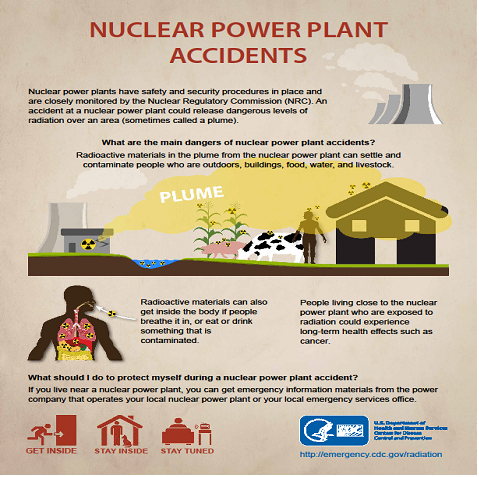
Exposure vs. Contamination
Content
Exposure:
- All or part of the body absorbs ionizing radiation from an external source.
- Once the source is shielded or the person moves away from it, absorption stops.
- Depending on this dose, the exposed person may be fine, may develop bad illness, or may have long term risk of chronic disease.
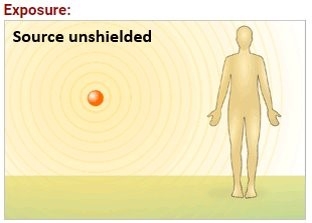
Contamination:
- Occurs when a radioisotope is released into the environment and then is ingested, inhaled, or deposited on the body surface.
- The radioactive material is ON or IN the person and continues exposing their cells to radiation.
- It is important to identify and remove the contamination as soon as possible to limit the dose.
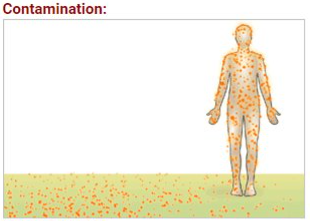
- Images and information: United States Department of Health & Human Services Radiation Emergency Medical Management
Preparing for a Nuclear or Radiological Emergency

Prepare Now for a Radiation Emergency
- Learn how to protect yourself and your loved ones in a Radiation Emergency
- Update your Emergency Supply Kit regularly
Survive During a Radiation Emergency
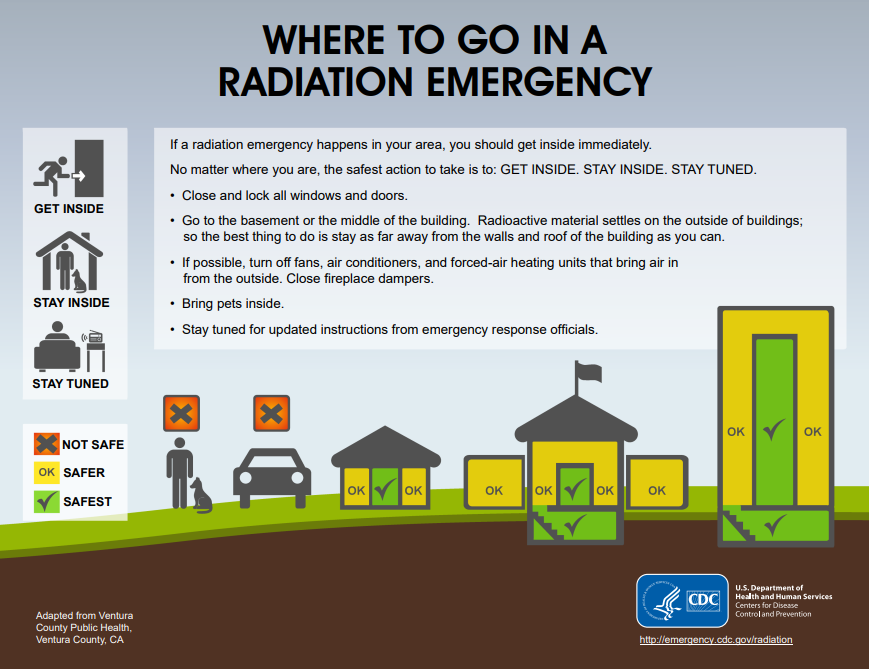
-
- GET INSIDE a building and prepare to take shelter for at least 24 hours
- Remove contaminated clothing, wash the parts of your body that were unprotected.
- Go to the basement or middle of the building.
- STAY INSIDE to reduce your exposure to radiation
- Stay inside for 24 hours unless local authorities provide other instructions.
- Close all doors and windows and shut off any systems that draw in outside air.
- Keep your pets inside.
- GET INSIDE a building and prepare to take shelter for at least 24 hours
-
- STAY TUNED for important information about how to keep you and your family safe.
- Stay tuned to local radio or television stations for the latest emergency information.
- Follow decontamination instructions from local authorities.
- Battery operated and hand crank emergency radios will be one of the best ways to stay tuned, they will function after a nuclear detonation.
- Emergency officials will tell you when to go to an emergency shelter or Community Reception Center, where the center or shelter is located, and the safest route for travel.
- Community Reception Center (CRC) may be opened in response to a radiological event
- Community Reception Centers (CRC’s) will be established to monitor and decontaminate a large, affected population.
- Community Reception Center (CRC) will provide services such as:
- Contamination screenings
- Decontamination for residents and pets
- Information on available shelters
- Mental health services
- Registration of all individuals exposed to radiation for long term follow up
- Distribute medication if necessary
- Act quickly and follow instructions.
- Each situation will be different and emergency officials will give you the best information to protect yourself and your loved ones.
- STAY TUNED for important information about how to keep you and your family safe.
Be Safe After Radiation Exposure and Contamination
- Learn about possible health effects
- Learn more about treatment options
- Learn other specialized information for certain groups of people
Resources: Nuclear and Radiological Preparedness
- Maryland Department of Emergency Management
- CDC Radiation Emergencies
- CDC Radiation Emergency Training, Education & Tools
- CDC National Center for Environmental Health
- United States Environmental Protection Agency
- United States Department of Health & Human Services Radiation Emergency Medical Management
- Federal Emergency Management Agency (FEMA)
- FEMA Geospatial Resource Center
- Ready.gov
Chemical/Biological Hazard Preparedness
What is a Chemical Hazard?
The CDC gives examples of Chemical Hazards that refer to any forms of chemicals including medications, solutions, gases, vapors, aerosols, and particulate matter that are potentially toxic or irritating to the body system. Chemical releases can be unintentional (industrial accident), or intentional (terrorist attack), and caution must also be taken with household chemicals. The Maryland Department of the Environment, in conjunction with local first responders, is the primary agency for handling chemical emergencies in Maryland. View tips here in case you need to shelter in place or evacuate due to a chemical hazard.
What Should you do in a Chemical Emergency?
Chemical emergencies can happen because of accidents such as a train derailment or through a deliberate release such as a terrorist attack.
Certain chemicals can harm you or your loved ones. If a chemical emergency happens, you may need to take steps to protect yourself and your family.
You should get away from the area of the chemical release. Do not worry about what type of chemical it might be. Focus on getting it off your body as soon as possible. Undress and shower, if you are able, ideally in the first 10 minutes. If you cannot undress and shower, wipe off as much of the chemical as you can. Then you should get help by calling the Poison Control Center at 800-222-1222 or calling 911 or going to the nearest hospital.
More Information:
- Chemical Emergencies (CDC)
- Chemical/Hazardous Materials Emergency (Maryland Department of Emergency Management)

Household Hazardous Waste Disposal
The Howard County Department of Public Works offers Household Hazardous Waste Disposal dates for residential customers.
Corrosive, flammable, reactive or toxic products, found in most homes, garages & workshops, are considered Household Hazardous Waste (HHW). These products pose risks if used, stored or disposed of improperly. Proper care is essential when dealing with Household Hazardous Waste.
Visit the Household Hazardous Waste page for more information.
Howard County Proximity to Peach Bottom Atomic Power Station
Howard County lies within a 50-mile radius from nuclear power plant located in southern Pennsylvania – the Peach Bottom Atomic Power Station. In the event of an accident causing a radioactive release at Peach Bottom Atomic Power Station, Howard County is subject to radiological hazards. Procedures are in place to help protect Howard County residents and other members of the public in the unlikely event of a nuclear emergency. Read more here.

